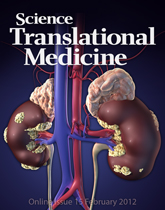
据美国物理学家组织网2月17日(北京时间)报道,麻省理工大学和该校微芯片公司最近宣称,他们15年前开始研究的遥控式药物递送微芯片已在人体实验中首次获得成功。他们通过简单的手术给骨质疏松患者植入了微芯片,经一年后检查发现疗效和采用注射方式相同。该实验的成功有望引领一个远程医疗的新时代。相关论文2月16日发表在《科学·转化医学》网站上。
这种芯片是一种可编程的、无线遥控式微芯片,可以事先编好用药剂量时间表,或通过一种名为“医疗植入通讯设备(MICS)”的专用无线电通讯频率远程控制药物释放,芯片植入病人体内后能按照用药规定管理日常的给药剂量。“用这种芯片,可以实现真正地按剂量服药。”麻省理工大学大卫·科赫学院教授罗伯特·朗格表示。该学院迈克尔·希玛说:“许多药物必须严格遵守用药规定,如果病人不得不自己给自己注射,情况就很麻烦。这项技术完全避免了这些麻烦,将来可以全自动地执行各种药物规定,一些慢性病人更能从中获益。”
2011年1月,他们在丹麦进行了人体临床实验,受试者是7位年龄从65到70岁之间的妇女。手术过程仅30分钟,芯片可在病人体内保存4个月。所用芯片中存放了20剂用于治疗骨质疏松的特利帕肽,分别密封在针眼大小的“仓库”里,仓库的盖子是一薄层铂钛合金,当施加一个微小电流时就会熔化,释放出里面的药物。一年后,研究人员检查受试者的骨质形成情况时,发现疗效和那些接受每日注射治疗的病人相同甚至更好。
该芯片目前的遥控距离只有几英寸,还有进一步延展空间。该论文领导作者、微芯片公司董事兼首席执行官罗伯特·法拉说,这种芯片不仅能用于骨质疏松症,还能用于其他多种疾病,包括癌症和多倍体硬化症,这将极大地改变治疗方式。

First-in-Human Testing of a Wirelessly Controlled Drug Delivery Microchip
Robert Farra, Norman F. Sheppard, Laura McCabe, Robert M. Neer, James M. Anderson, John T. Santini Jr. , Michael J. Cima5 and Robert Langer
The first clinical trial of an implantable microchip-based drug delivery device is discussed. Human parathyroid hormone fragment [hPTH(1-34)] was delivered from the device in vivo. hPTH(1-34) is the only approved anabolic osteoporosis treatment, but requires daily injections, making patient compliance an obstacle to effective treatment. Furthermore, a net increase in bone mineral density requires intermittent or pulsatile hPTH(1-34) delivery, a challenge for implantable drug delivery products. The microchip-based devices, containing discrete doses of lyophilized hPTH(1-34), were implanted in 8 osteoporotic postmenopausal women for 4 months and wirelessly programmed to release doses from the device once daily for up to 20 days. A computer-based programmer, operating in the Medical Implant Communications Service band, established a bidirectional wireless communication link with the implant to program the dosing schedule and receive implant status confirming proper operation. Each woman subsequently received hPTH(1-34) injections in escalating doses. The pharmacokinetics, safety, tolerability, and bioequivalence of hPTH(1-34) were assessed. Device dosing produced similar pharmacokinetics to multiple injections, and had lower coefficients of variation. Bone marker evaluation indicated that daily release from the device increased bone formation. There were no toxic or adverse events due to the device or drug, and patients stated that the implant did not impact quality of life.








